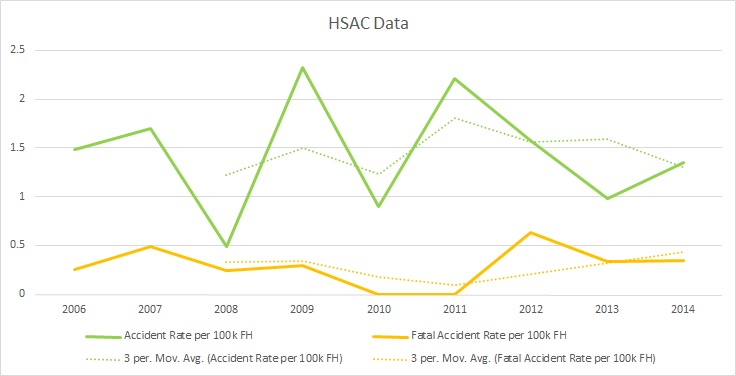Helicopter Ops and Safety – Gulf of Mexico 2014
The Helicopter Safety Advisory Conference (HSAC) has been publishing data on the Gulf of Mexico (‘GOM’) offshore helicopter fleet and its safety since 1995.
Helicopter Operations: GOM Fleet Data
They report that flying activity has remained “relatively constant” for the last several years, with just under 300k flying hours, using 415 helicopters, operated by 13 companies in 2014 (the big three are Bristow, ERA and PHI, with RLC strong in the single engine sector).
However, flying hours, passenger numbers and flights have dropped by 11-12% over the last 5 years. The drop is even more significant since the peak of 2008 (30%, 28% and 40% respectively).
The number of single engine helicopters continues a “slow decline”, down 14% since 2010, 26% since 2008 and 37% since 2005. In fact, in 2005, the single engine fleet was 424, more than the total for all types in the current GOM fleet. This perhaps is indicative of the economic decline in the small ageing coastal fields.

PHI S-92A (Credit: PHI)
The number of heavy twins (mainly Sikorsky S-92As and with a few Airbus Helicopters H225s) however has doubled in the last 5 years, trebled in the last 10 and increased 8.6 fold since 1997, as more deepwater exploration and production has occurred (as demonstrated by the last few seconds of the animated map below, a 2008 MMS report and a deepwater field status listing).
Between 2013 and 2014 there was also a noticeable 21% drop in the number of medium twins. However flying hours dropped by just 3%, suggesting the GOM operators have retired many of the older aircraft, Sikorsky S-76As in particular, and are now achieving higher utilisation.
In fact in 2014 the average utilisation was:
- Single engine – 590 flying hours (average 20 minute sector length)
- Light twin – 441 flying hours (average 17 minute sector length)
- Medium twin – 794 flying hours (average 38 minute sector length)
- Heavy twin – 805 flying hours (average 36 minute sector length)
The medium / heavy twin usage per aircraft is approximately 20% less that the average for the UK North Sea fleet.
Helicopter Safety GOM
There were just two accidents in 2014 using NTSB data (one fatal, with two fatalities). There were however also two ditchings in 2014, both due to loss of engine power. These were not recorded as accidents by the NTSB (as would have been the case in most other countries). Consequently, according to HSAC:
- The 2014 accident rate was 0.68 per 100k flying hours (or more correctly 1.35 counting all four occurrences) compared to a 31-year annual average accident rate of 1.74.
- The 2014 fatal accident rate was 0.34 per 100k flying hours compared to a 31-year annual average accident rate of 0.44.
We covered the fatal accident last year in more detail.
UPDATE 17 February 2016: Having completed a study of the US HEMS safety record we have also plotted HSAC data (including all ditchings as accidents), first back to the start of the start of the International Helicopter Safety Team (IHST) in 2006:
Although there is year on year variability, no long term improvement is evident (and while the 3 year rolling average accident rate has dropped in recent years, the 3 year rolling average fatal accident rate has climbed).
If we look over the full span that HSAC published data:
Here a rise of accidents (but not fatal accidents) from the mid 1990s is evident, peaking in 2003, before a decrease to more steady performance from 2006 onwards.
UPDATE 30 July 2016: Our 2015 review.
UPDATE 3 June 2017: Our 2016 review.
UPDATE 23 June 2018: Our 2017 review.
UPDATE 28 February 2019: Our 2018 review.
UPDATE 20 December 2020: HSAC finally release their 2019 data: Helicopter Ops and Safety – Gulf Of Mexico 2019 Update



Recent Comments